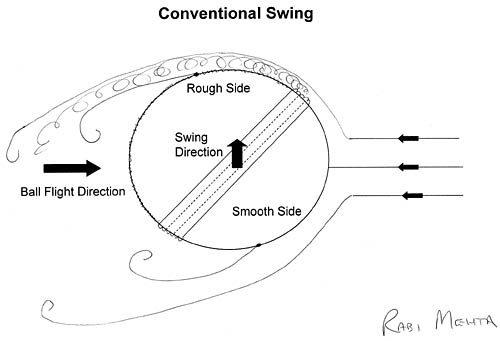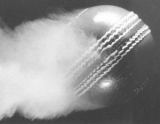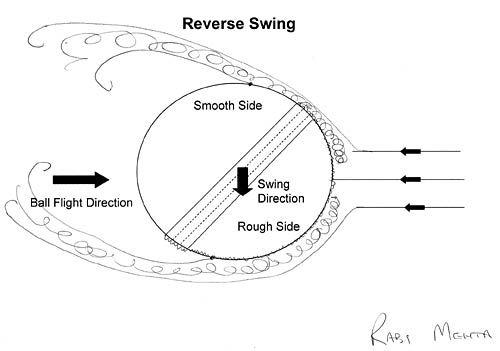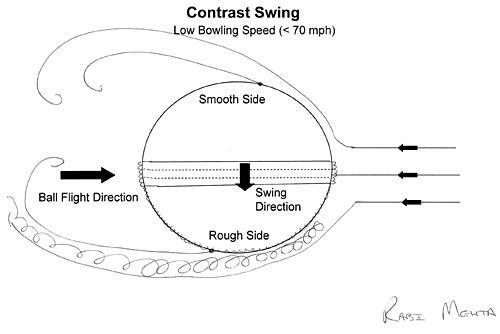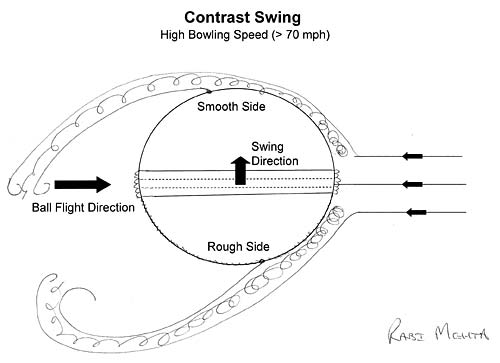Conventional swing, reverse swing, contrast swing. In the past few years cricketers have been barraged with new and convoluted descriptions of a ball's deviation through the air, but only the select few can differentiate between each, let alone unravel the science behind them. One such man is Rabindra Mehta, a NASA scientist and former club fast bowler based in California, who has studied cricket-ball aerodynamics for nearly three decades. Here, in response to an article published at Cricinfo last week, he gives the definitive answer to the mysteries of swing. Does it really matter what you call a particular type of swing? Well, it matters because the science dictates what type of swing it is. Of course, bowlers do not have to know or understand the science, but I'm sure they would appreciate knowing when a certain type of swing will be effective and in which direction the ball is likely to swing.
Having studied cricket ball aerodynamics for over 25 years, my mission here is to reveal the answers to all the mysteries surrounding swing bowling, and hopefully, to quash once and for all, all the myths and erroneous explanations that are still floating around the cricketing world. To assure you that these three types of swing do actually exist, and are regularly practised on the cricket ground, I have quoted examples from the famous 2005 Ashes series between England and Australia.
Let us first look at some of the fundamental flow physics that will help to explain all three types of cricket ball swing. As the ball is flying through the air, a thin layer of air called the "boundary layer" forms along the ball's surface. The boundary layer cannot stay attached to the ball's surface all the way around the ball and it tends to leave or "separate" from the surface at some point. The location of this separation point determines the pressure, and a relatively late separation results in lower pressure on that side. A side force or swing will only be generated if there is a pressure difference between the two sides of the ball.
Now the boundary layer can have two states: a smooth and steady "laminar" state, or a time-varying and chaotic "turbulent" state. The transition from a laminar to a turbulent state occurs at a critical speed that is determined by the surface roughness; the rougher the surface the lower the critical speed. However, on a very smooth surface and at nominal speeds, a laminar boundary layer can be forced to turn turbulent by "tripping" it with a disturbance. The disturbance can be in the form of a local protuberance or surface roughness which adds turbulent eddies to the laminar layer and forces it to become turbulent. It is similar to putting your finger into a smooth stream of water from a tap: note how small chaotic turbulent motions are generated downstream of the finger location. Now it turns out that a turbulent boundary layer (because of its increased activity and energy) can stay attached to the ball's surface for a longer distance compared to a laminar layer.
It is said that this type of swing originated around the turn of the century, but there is evidence that it was in existence well before that time. Bowlers from that era, including WG Grace, had realised that a perfectly new ball favoured the "peculiar flight," so there is not much doubt that it was conventional swing that these bowlers were referring to.
Fast bowlers in cricket make the ball swing by judicious use of the primary seam. The ball is released with the seam at an angle to the initial line of flight. For conventional swing, the ball swings in the same direction that the seam is pointing. So a ball released with the seam angled towards the slip fielders will swing away from the batsman (outswinger) and one released with the seam pointed towards fine leg will swing into the batsman (inswinger). A great example of inswing can be found in the first innings of the fourth Test when Marcus Trescothick was bowled by Shaun Tait, and for outswing, check out Simon Jones to Michael Kasprowicz when Australia's turn came to bat.

|
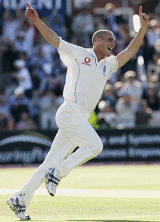
Simon Jones: a fine exponent of conventional swing
© Getty Images
|
|
So how and why does a cricket ball swing in the conventional mode?
Let us see what happens to the flow over a cricket ball released with the seam angled (Fig. 1). Between about 30 and 70 mph, the laminar boundary layer along the bottom surface separates at about the apex of the ball. However, the boundary layer along the top surface is tripped by the seam into a turbulent state and its separation is therefore delayed. This asymmetry results in a pressure differential (lower pressure over the top) and hence side force which makes the ball swing in the same direction that the seam is pointing (upwards).
So this is the theory. Does this really occur in practice? The photograph in Fig.2 shows a cricket ball with the seam angled and held in a wind tunnel. The flow is from right to left and smoke is injected into the region behind the ball. It is seen clearly how the boundary layer over the bottom surface separates relatively early compared to that over the top. Also, the clean, smooth edge of the smoke at the bottom separation point indicates a laminar boundary layer while the rather chaotic nature of the smoke near the top separation point indicates a turbulent state.
The key to successful conventional swing is to keep that leading side (the one facing the batsman) as smooth as possible so that a laminar separation is obtained. So the age-old practice of polishing the ball makes a lot of scientific sense (I also liked the fact that the bright red patch on my trousers identified me as a fast bowler). In prior years, bowlers were accused of using "Vaseline" or "Brylcreem" to aid the polishing process. Lately though, the buzz is all about how some special mints or sweets can help the saliva become a more effective polishing agent. I am not sure about this, but what I do know is that once the lacquer is worn off the surface, the natural oils in the leather are released and this helps the polishing process.
Of course, in reality, some backspin is always imparted when a cricket ball is bowled. For successful swing bowling, the ball should be released so that it spins along the seam with minimal wobble. Wind-tunnel tests on spinning cricket balls show that the maximum side force is generated at about 70 mph with the seam angled at 20 degrees and the ball spinning backwards at 11 revolutions/second.
So what happens at speeds above 70 mph? The boundary layer on the bottom side in Fig. 1 begins towards transition, the asymmetry is reduced and so is the swing such that at around 80 mph there is no swing. So if you are unfortunate enough to bowl at around this critical speed, the ball will not swing, no matter how perfectly the ball is released. In a recent conversation with Mike Hendrick, the former England fast bowler, he revealed to me that he always found it very difficult to swing the ball and after all these years, he finally figured out why when he saw our data. Of course one solution is to slow down a bit. But, what if the bowler puts in the extra "oomph" and releases a much faster delivery? Can you, say, "reverse swing"?
My former schoolfriend, Imran Khan, is rightly regarded as one of the first and finest exponents of reverse swing. In August, 1980, around the time I published my first article on cricket-ball aerodynamics in the New Scientist magazine (Vol. 187, No. 1213), he told me out of the blue that, on occasions, the ball would swing the "wrong way". He was predominantly an inswing bowler at the time and so the "wrong way" meant that the ball would swing away from the batsman. At the time, I honestly did not believe that such a phenomenon could occur since I could not explain it scientifically. However, in the following year, when we conducted our wind-tunnel experiments, the whole "mystery" was revealed.
The flow over a ball exhibiting reverse swing is shown in Fig. 3. So now, at a high enough bowling speed (over about 85mph for a new ball) the laminar boundary layer transitions into a turbulent state relatively early, more importantly before reaching the seam location. In this case, the seam actually has a detrimental effect on the turbulent boundary layer by making it thicker and weaker and it therefore separates earlier than the turbulent layer over the bottom surface.

|
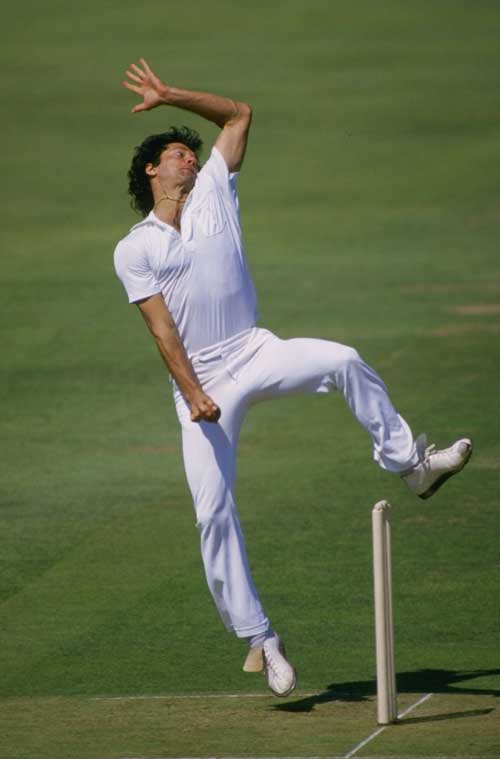
Imran Khan: one of the first and finest reverse-swingers
© Getty Images
|
|
Still following this at the back of the class? That means that the asymmetry is now switched and so is the side force. Result: the ball swings in the opposite or reversed direction. It is only true reverse swing if the ball swings in a direction that is opposed to that of the seam. This means that the fastest bowlers in the world who bowl at over 90mph will only produce reverse swing, even with a brand new ball.
Of course, not many bowlers can bowl at 90mph so how can us mere mortals produce reverse swing? Well, that is where the surface roughness comes into play. As the roughness on this leading side (facing the batsman) is increased, the critical bowling speed above which reverse swing can be obtained is reduced (experimental data showing this effect can be found in a New Scientist magazine article, Vol. 139, No. 1887, August 21st 1993). It also means that more effective reverse swing will be obtained at the higher bowling speeds.
This is why reverse swing generally comes into play with older balls. The whole beauty of reverse swing is that a bowler who could only bowl outswingers at the onset with the new ball can bowl inswingers with an older ball without any change in the grip or bowling action. Similarly, an inswing bowler will suddenly be able to bowl outswingers. For a classic exposition of reverse swing, check out last summer's third Test, Andrew Flintoff to Simon Katich in the second innings.
One of the reasons why reverse swing has gained such notoriety is its constant link to accusations of ball-tampering, as we just witnessed at The Oval. Once bowlers realised the importance of the rough surface, they started to help the process along. After Mike Atherton's "dirt in the pocket" affair in 1994, I was duly summoned to Lord's by the TCCB. They showed me several balls that had been confiscated after the umpires suspected the fielding side of ball-tampering. From what I saw, the most popular forms of tampering consisted of gouging the surface using foreign objects such as bottle tops and attempting to open up the quarter seam using fingernails.
Perhaps what is not that well-known is the fact that positive roughness can work just as well. So if some dirt was stuck to the ball's surface (using sweat or saliva as the glue), reverse swing could be obtained at nominal bowling speeds on even a brand new ball, and best of all, the evidence is gone by the time the ball reaches the wicketkeeper. Is that what Atherton was attempting? I doubt it, but I wonder if other players ever tried it, especially in the days when sawdust was routinely used to dry a wet ball.
The one misconception about reverse swing that is commonly heard (even today) is that it occurs due to a weight imbalance created by wetting one side of the ball. This is based on comments made by some of the early exponents of reverse swing, but it has NO scientific basis to it whatsoever. Wetting the ball may indeed help in the gouging process, but the importance of a dry, rough surface is now well understood by the current players who are often seen avoiding hand contact with the rough surface.
Another misconception is that reverse swing is more lethal because the ball swings more and late. It turns out the side-force magnitude and direction for reverse swing are comparable to those for conventional swing and for both types of swing, the ball follows a parabolic flight path so that most of the movement occurs in the latter part of the flight. Bottom line: late swing is "built-in."
My personal attempts at ball-tampering never really materialised. By the time I figured it out, I found myself playing in California and our team captain - who was also the opening bowler - refused to let me tamper with the ball; he was convinced that my actions would "screw up" his beautiful outswing. The fact is that the condition of the "back side" of the ball (the upper surface behind the seam in Figs. 1 and 2) is not very critical. So the perfect ball for conventional and reverse swing is one with one side very smooth and the other rough. There is also another advantage in creating a ball with a sharp contrast in surface roughness.
Contrast Swing
On a visit to the ECB National Cricket Academy last December, where I was invited to present my research on cricket ball aerodynamics, I realised that there was still some confusion regarding the definition of reverse swing. They had a practice session devoted to reverse swing with specially-prepared balls (one side deliberately roughened). Some of the bowlers swung the ball quite well and they thought in the reverse sense.
However, the ball generally had the seam straight up (not angled) and swung towards the smooth side. This was obviously not reverse swing and it was somewhat difficult for me to explain to the bowlers and coaches what was going on. That is when I developed the new term: "contrast swing." So how is contrast swing different from conventional and reverse swing? For one thing, the swing direction is determined by the bowling speed, as opposed to seam and smooth/rough surface orientations.

|
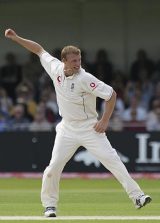
Andrew Flintoff uses contrast swing to great effect
© Getty Images
|
|
In Fig. 4(a), a ball with a contrasting surface roughness is flying through the air at a relatively low speed with the seam straight up. In this case, the boundary layer over the upper surface separates relatively early in a laminar state while that on the bottom rough side becomes turbulent and separates later. This asymmetry results in a side force which makes the ball swing towards the rough side.
If the ball is released at a much higher speed, the flow field is different as shown in Fig. 4(b). In this case, transition occurs on both sides of the ball, but the turbulent boundary layer along the rough bottom surface is thickened and weakened (in the same way that the seam weakens the turbulent boundary layer in reverse swing). As a result the boundary layer on the rough side separates relatively early and the ball now swings towards the smooth side.
Note that the actual critical bowling speed that determines which way the ball will swing is totally determined by the condition of the ball. Superb examples of true contrast swing can be found in the second innings of the third Test, Flintoff to Matthew Hayden and Flintoff to Adam Gilchrist.
The most exciting feature about contrast swing is that just about any bowler (regardless of bowling speed) can implement it in practice. As most cricketers are aware, it is much easier to release the ball with the seam straight up, rather than angled towards the slips or fine leg. Thus, even mere mortals should be able to swing such a ball, and in either direction, since the bowling action is the same for both types of swing, the only difference being the orientation of the ball.
In fact, the medium-pace "seam" or "stock" bowlers usually bowl with the seam in this orientation in an attempt to make the ball bounce on its seam so that it may gain sideways movement off the ground. With a contrast in surface roughness, these bowlers could suddenly turn into effective swing bowlers, without any additional effort, thus confusing not only the batsman, but perhaps themselves as well. Another advantage of contrast swing is that it can be obtained even if the seam is completely "bashed-in" (note that a prominent seam is critical for conventional and reverse swing). If you doubt that a ball with a bashed-in seam can contrast swing, then tape over one half of a tennis ball and bowl it with the junction line straight up.
So the ideal ball for swing bowling is one with a prominent seam, one side smooth and the other rough. The fielding side should examine the new ball and choose the side with the shallower or less rough embossment and religiously polish that side throughout the match. The other side should be allowed to roughen during the course of play, but it should be kept as dry as possible.
Even if the seam gets completely bashed-in, a ball with a contrast in surface roughness can be swung. So how do you tell what type of swing a particular bowler is producing? Make note of the seam orientation and swing direction. If they are coincident, it is conventional swing; if opposed, it is reverse swing and if the seam is pointing straight down the pitch, you have just witnessed contrast swing.
Rabindra Mehta is a Sports Aerodynamics Consultant and NASA Scientist based in California (rabi44@aol.com).
